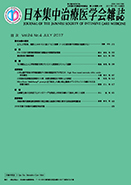Volume 24, Issue 4
Displaying 1-10 of 10 articles from this issue
- |<
- <
- 1
- >
- >|
-
2017Volume 24Issue 4 Pages 371
Published: July 01, 2017
Released on J-STAGE: July 05, 2017
Download PDF (136K)
HISTORY OF INTENSIVE CARE MEDICINE IN JAPAN
-
2017Volume 24Issue 4 Pages 373-382
Published: July 01, 2017
Released on J-STAGE: July 05, 2017
Download PDF (990K)
REVIEW ARTICLES
-
2017Volume 24Issue 4 Pages 383-388
Published: July 01, 2017
Released on J-STAGE: July 05, 2017
Download PDF (337K) -
2017Volume 24Issue 4 Pages 389-397
Published: July 01, 2017
Released on J-STAGE: July 05, 2017
Download PDF (486K)
ORIGINAL ARTICLE
-
2017Volume 24Issue 4 Pages 399-405
Published: July 01, 2017
Released on J-STAGE: July 05, 2017
Download PDF (329K)
CASE REPORTS
-
2017Volume 24Issue 4 Pages 407-411
Published: July 01, 2017
Released on J-STAGE: July 05, 2017
Download PDF (1125K) -
2017Volume 24Issue 4 Pages 412-416
Published: July 01, 2017
Released on J-STAGE: July 05, 2017
Download PDF (342K) -
2017Volume 24Issue 4 Pages 417-420
Published: July 01, 2017
Released on J-STAGE: July 05, 2017
Download PDF (216K)
BRIEF REPORT
-
2017Volume 24Issue 4 Pages 421-422
Published: July 01, 2017
Released on J-STAGE: July 05, 2017
Download PDF (264K)
INVESTIGATION REPORT
-
A multicenter survey on distribution of the workload related to continuous renal replacement therapy2017Volume 24Issue 4 Pages 423-425
Published: July 01, 2017
Released on J-STAGE: July 05, 2017
Download PDF (253K)
- |<
- <
- 1
- >
- >|
